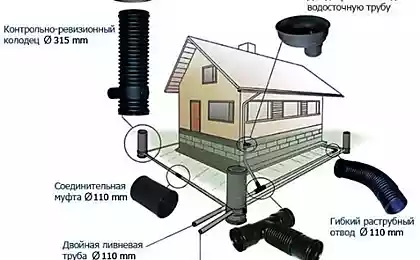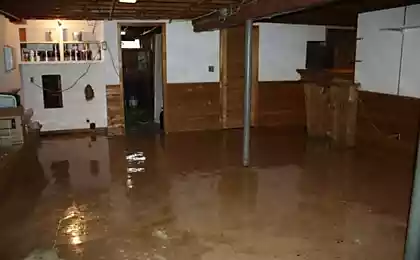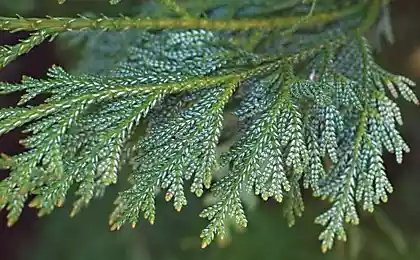669
How to make a drainage at the site
The need for drainage of the site occurs in the area where located close to ground water and sees a significant amount of rain. In order to avoid leaching and waterlogging of the soil, and cleaning the foundations and flooding basements should take a professional approach to the organization of the drainage system.

For the first time the system of collection and removal of water beyond the land plots were created in Ancient Babylon, and in spite of the fact that after a century of technology has advanced considerably, today the drainage area is produced on the same principle.
Varieties of drainage systemsFor the purpose of the drainage system are divided into the following types:

Surface drainage area in turn is divided into:

Deep drainage of the site can be:

If your location is possible heavy rains, should choose a hybrid system that includes an underlying drainage area and stormwater. Drainage can be both point and linear.Preparation for construction of the drainage systemThere are several types of sites which are guaranteed not to do without dehumidification. These include:
Select the type of drainage garden plot should be based on the territorial bump. However, before thinking about what kind of draining soil to give preference to, you need to know that there aretwo kind of system:

On the side where the water comes from, the trench should have a slope of approximately 30 degrees to the flow of water took place as much as possible. Thus digs right amount of ditches that connect one ending well. Next, you need to check whether there is enough bias, since if it is too small, then this place will be the stagnation of water. In such a situation, you just need to change the slope of the sewage ditches to keep moisture away quickly even during heavy rainfall.
In a drainage system of open type have a significant drawback – the unpresentable appearance. To compensate, the ditch is filled with gravel: below, a larger fraction, and above – smaller. The material must be large enough, but for the top layer, it is permissible to use smaller gravel or pebbles.
Closed systemDrainage suburban area closed (deep) is required for areas where ground water is located very high. It will guard you from flooding the basement of the house.This method requires more effort and cost compared to an open drain system, because it can not do without laying pipe.

The embedding depth of the pipe depends on the type of soil and 60 cm for clay and 100 cm for sandy. The diameter of the main pipe is 100 mm and the additional slightly less than 75 mm.
The scheme of the drainage area of the closed type is called a "Christmas tree", by way of pipes. This system involves mandatory elements: a ditch or well for flow. The device of this design will require a lot of effort, but will pay off in dry times as water from gutter can be applied when watering the garden.
For dehumidification systems using corrugated perforated plastic pipe. They are environmentally friendly, do not cause difficulties during installation, are inexpensive. The process of installation depends on the type of soil on the site.
The high content of clay will require using special filter material. If the soil type is gravel – it is necessary to put under the pipe gravel (layer thickness about 20 cm). If the soil at the site is loamy – pipe wrapped with geotextile. Lately you can buy a ready wrapped pipe and immediately begin to self-installation of drainage at their summer cottage.
Proper drainageTips that will help you make the right drainage:

Proper drainage of the site involves the use of a geotextile. Wrapping perforated pipe with a geotextile, you will eliminate the risk of ingress of sand. Also don't forget aboutthe sand traps. This is a special device that is able to hold small debris (sand, plant seeds, leaves, anything that can clog stormwater drainage). The system of drainage, is equipped with a sand trap will work as efficiently as possible, quickly coping with a significant volume of liquid.
Proper drainage areas on the slopesIf your site is located on the slope of the first ditch should be dug in the uppermost part. This will prevent waterlogging of the soil on the territory below. Second, the ditch should be parallel to the first and to be in the lowest part of the estate. Connect the two ditch can be a trench in which in the future will be laid underground pipe. All water from the site will be collected in the lower gutter and drain to storage or drain well. To the walls of the ditches over time, not showered, they should be performed at an angle of 20-30°. In a similar way are trenches for deep drainage using pipes.

Proper drainage of the open type it is possible to do with their hands, and quite quickly. But the installation of the deep system will require certain knowledge and skills, substantial labor and ramasutra.
Construction worksAfter purchased the materials and determined the place for the future of the gutter, you can start the installation. First, dig ditches, the bottom of which is draped with geotextile (it is necessary to lay stock). If you don't want to use geotextile — then on the bottom it is necessary to lay a sand layer about 10 cm or slightly more. Top of the pipe backfilled with expanded clay or very large gravel. The top layer put the soil removed during the digging of trenches.

You must follow the angle of the pipes. The correct figure is 7 cm on a 10 m pipe. A connected part of the pipes, tees or crosses.
The sewage in the drainage usually occurs in a specially made pit. It is easier to collect it from the rings of the reinforced concrete that you can buy off the shelf. Another, less costly option, is to use containers of plastic.
Set well sums up the pipe. To freely place the drain accumulated fluid in the upper part of the well is mounted a pipe. If this is not possible, the resulting water is pumped by the pump.
If you've decided to undertake the drainage of the site, our advice will help you to do this in a short time and with savings. The whole complex of works will take a few days.published
P. S. And remember, only by changing their consumption — together we change the world! ©
Join us in Facebook , Vkontakte, Odnoklassniki
Source: aquagroup.ru/articles/kak-sdelat-drenazh-na-uchastke.html

For the first time the system of collection and removal of water beyond the land plots were created in Ancient Babylon, and in spite of the fact that after a century of technology has advanced considerably, today the drainage area is produced on the same principle.
Varieties of drainage systemsFor the purpose of the drainage system are divided into the following types:
- surface (open type),
- deep (closed).

Surface drainage area in turn is divided into:
- point. In the organization point system uses inlets, sumps (drain outfalls), storm flap and ladders. The inlets are installed directly under the drain plums roofs, door receipts under watering pipes and valves, as well as in those places where it requires a local collection of water. Point catchment will effectively complement linear drainage where necessary effective and rapid drainage from the site. The cisterns are connected by underground pipes through which water enters the well of stormwater. Point drainage area can effectively remove the excess moisture that fell as rain. Mandatory conditions the quality of this system is its regular cleaning and professional service.
- linear. Can be both wall and remote from buildings. The linear system consists of trays with grating designed to receive rainfall, not included in dot's sewage system. Point of the watershed is storm well. This option is most relevant for areas where groundwater is not too close to the surface. Device storm drainage system does not provide for extensive surface preparation. All that is required is to create flatter slopes on both sides of the drain line. This will help to reduce the risk of shrinkage of the soil, reduce the length of stormwater channels, to increase the catchment area. With the stormwater drainage drainage system is connected through horizontal and vertical bends. To improve the efficiency of the system, experts recommend to equip it with a sand trap;
- Deep drainage of the site. The construction of the root system produced in areas where the groundwater is located at a distance of up to 2.5 meters, and it requires a significant amount of earthworks. Therefore, specialists recommend to start it before the start of construction of the house.

Deep drainage of the site can be:
- pipe. Used when groundwater at the site overlain by deep. It need a pipe with perforation (drains). Pipe laid underground at a certain slope, moisture gets into them through the holes and transported to the collection site (cumulative wells, drainage tunnel, a well, stormwater);
- Plast. One of the most common types of deep drainage system. He laid at the base of the building and provides for the organization of filter gravel cushion.

If your location is possible heavy rains, should choose a hybrid system that includes an underlying drainage area and stormwater. Drainage can be both point and linear.Preparation for construction of the drainage systemThere are several types of sites which are guaranteed not to do without dehumidification. These include:
- located on land with a high clay content , even with a little rain on the plot will always stand puddles;
- with a high threshold of groundwater;
- with smooth surface, whereby the water has no opportunity anywhere to drain;
- located at the bottom of the slopes – when floods or melting snow flooded them immediately.
Select the type of drainage garden plot should be based on the territorial bump. However, before thinking about what kind of draining soil to give preference to, you need to know that there aretwo kind of system:
- open;
- closed.

On the side where the water comes from, the trench should have a slope of approximately 30 degrees to the flow of water took place as much as possible. Thus digs right amount of ditches that connect one ending well. Next, you need to check whether there is enough bias, since if it is too small, then this place will be the stagnation of water. In such a situation, you just need to change the slope of the sewage ditches to keep moisture away quickly even during heavy rainfall.
In a drainage system of open type have a significant drawback – the unpresentable appearance. To compensate, the ditch is filled with gravel: below, a larger fraction, and above – smaller. The material must be large enough, but for the top layer, it is permissible to use smaller gravel or pebbles.
Closed systemDrainage suburban area closed (deep) is required for areas where ground water is located very high. It will guard you from flooding the basement of the house.This method requires more effort and cost compared to an open drain system, because it can not do without laying pipe.

The embedding depth of the pipe depends on the type of soil and 60 cm for clay and 100 cm for sandy. The diameter of the main pipe is 100 mm and the additional slightly less than 75 mm.
The scheme of the drainage area of the closed type is called a "Christmas tree", by way of pipes. This system involves mandatory elements: a ditch or well for flow. The device of this design will require a lot of effort, but will pay off in dry times as water from gutter can be applied when watering the garden.
For dehumidification systems using corrugated perforated plastic pipe. They are environmentally friendly, do not cause difficulties during installation, are inexpensive. The process of installation depends on the type of soil on the site.
The high content of clay will require using special filter material. If the soil type is gravel – it is necessary to put under the pipe gravel (layer thickness about 20 cm). If the soil at the site is loamy – pipe wrapped with geotextile. Lately you can buy a ready wrapped pipe and immediately begin to self-installation of drainage at their summer cottage.
Proper drainageTips that will help you make the right drainage:
- Decide on the type of drainage system
- If in your area there was abundant precipitation, for quick drainage need surface drainage. But for the lowering of the groundwater level should be to organize a system of deep drainage. To determine whether the drainage system in your yard, you should conduct a simple test. Dig on the plot hole depth of 0.6 m and fill it with water. If during the day the water is gone, the need for drainage is no, but if the water in the pit, this means that the soil at the site is quite dense and without a system of drainage should be provided.
- In the design process correctly calculate the load of the system
- The degree of load on the system depends on the soil characteristics at the site, the filtration coefficient in different time of year, saturable soil moisture, amount of water inflow. If you mount a household drainage system, load will be low, it is possible to use polymer drains, plastic trays and grates. If you expected a serious load on the system, from the plastic components should be abandoned. Proper drainage will include the use of the channels, troughs and wells concrete.
- Use high-quality materials.
- Take care of the filters

Proper drainage of the site involves the use of a geotextile. Wrapping perforated pipe with a geotextile, you will eliminate the risk of ingress of sand. Also don't forget aboutthe sand traps. This is a special device that is able to hold small debris (sand, plant seeds, leaves, anything that can clog stormwater drainage). The system of drainage, is equipped with a sand trap will work as efficiently as possible, quickly coping with a significant volume of liquid.
Proper drainage areas on the slopesIf your site is located on the slope of the first ditch should be dug in the uppermost part. This will prevent waterlogging of the soil on the territory below. Second, the ditch should be parallel to the first and to be in the lowest part of the estate. Connect the two ditch can be a trench in which in the future will be laid underground pipe. All water from the site will be collected in the lower gutter and drain to storage or drain well. To the walls of the ditches over time, not showered, they should be performed at an angle of 20-30°. In a similar way are trenches for deep drainage using pipes.

Proper drainage of the open type it is possible to do with their hands, and quite quickly. But the installation of the deep system will require certain knowledge and skills, substantial labor and ramasutra.
Construction worksAfter purchased the materials and determined the place for the future of the gutter, you can start the installation. First, dig ditches, the bottom of which is draped with geotextile (it is necessary to lay stock). If you don't want to use geotextile — then on the bottom it is necessary to lay a sand layer about 10 cm or slightly more. Top of the pipe backfilled with expanded clay or very large gravel. The top layer put the soil removed during the digging of trenches.

You must follow the angle of the pipes. The correct figure is 7 cm on a 10 m pipe. A connected part of the pipes, tees or crosses.
The sewage in the drainage usually occurs in a specially made pit. It is easier to collect it from the rings of the reinforced concrete that you can buy off the shelf. Another, less costly option, is to use containers of plastic.
Set well sums up the pipe. To freely place the drain accumulated fluid in the upper part of the well is mounted a pipe. If this is not possible, the resulting water is pumped by the pump.
If you've decided to undertake the drainage of the site, our advice will help you to do this in a short time and with savings. The whole complex of works will take a few days.published
P. S. And remember, only by changing their consumption — together we change the world! ©
Join us in Facebook , Vkontakte, Odnoklassniki
Source: aquagroup.ru/articles/kak-sdelat-drenazh-na-uchastke.html
This product accelerates the fat metabolism in the body and reduces the level of cholesterol in the blood
34 simple things as men that women push them away























